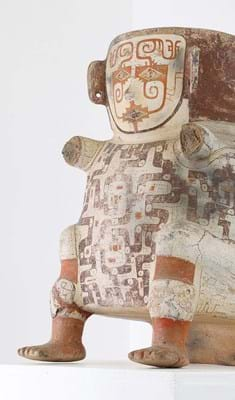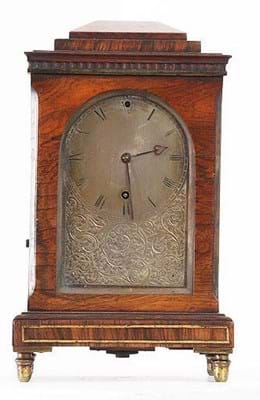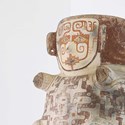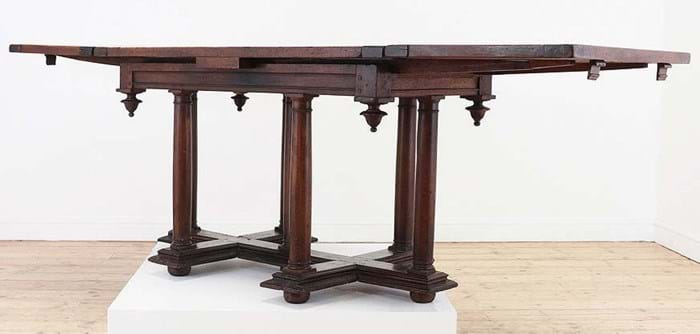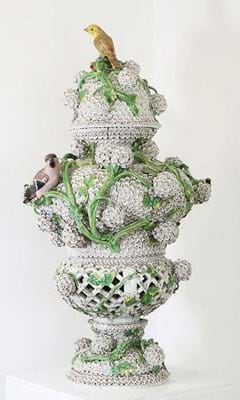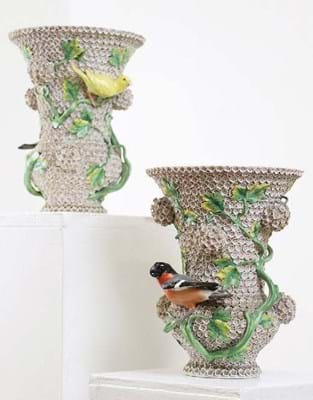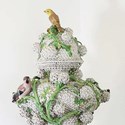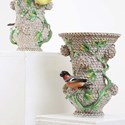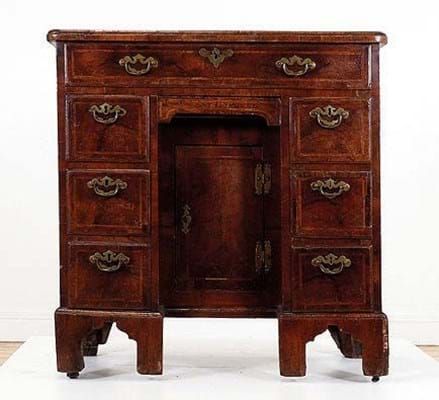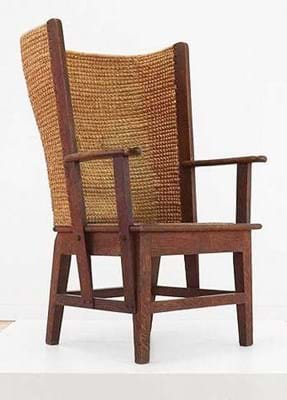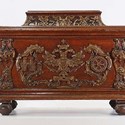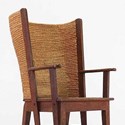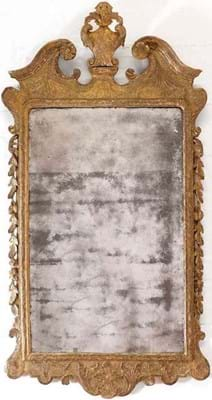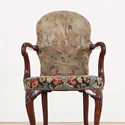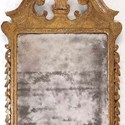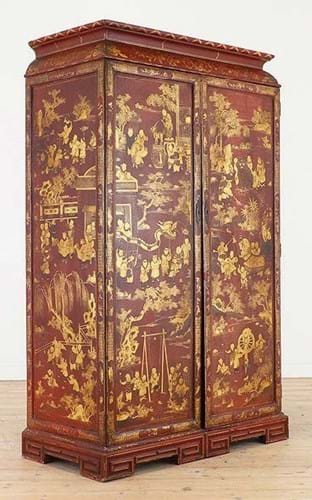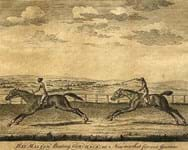Pottery vessels of this figural type were made in the 16th-18th centuries by the Omagua culture who inhabited the banks of the Napo River in the second millennium AD.
With its vibrant black geometric patterns on a cream ground, the 19in (48cm) high urn would have housed the remains of an important figure in the tribe. Scientific analysis has estimated it was fired between 300 and 450 years ago.
It came by descent from Austin Baillon, an executive with Shell in Venezuela where he also occupied a position as British vice-consul. It was during this period (before 1975) that he spent time in Ecuador and acquired two of these Omagua pottery vessels.
This example, expected to sell for £3000-5000 at the auction in the Stansted Mountfitchet saleroom on March 14-15, attracted bidding from several phone and internet bidders before going to a private client in Belgium at £8000.
Good sport
Art and antiques from half-a-dozen named private collections formed the core of this spring sale - and the preeminent lots.
Seventy-six lots came from the estate of John Scott-Oldfield, a Cambridge athletics blue and Harlequins rugby player turned titan of the corporate world.
The interior of his flat in London SW1 was a textbook example of blending periods and styles: a thoughtful mixture of objects from Renaissance Europe, Qing dynasty China and Georgian England.
A French ‘Croix de Lorraine’ table was the family dining table - occasionally laid for guests with a modern 82-piece Herend porcelain ‘Rothschild Bird’ pattern dinner service that sold at £3500.
Renaissance era draw-leaf dining tables of this sort take their title from the shape of the stretcher and are commonly linked with the Loire Valley, although ultimately follow the designs and motifs of Tuscan architecture. This one was formerly in the collection of Georges Hoentschel (1855-1915), the successful Parisian decorator and proprietor of Maison Leys and then the US financier John Pierpont Morgan (1837-1913).
Accessioned to the Metropolitan Museum, New York, in 1916, it was deaccessioned at Sotheby’s in 1995 - probably as it is now known to comprise both 16th and 19th century elements. Given a guide of £6000- 8000, it got away at the low estimate.
A handful of similar tables have appeared for sale in recent years: the ‘16th century and later’ example in the Christie’s sale titled ‘Au Bord Du Lac: An interior by François-Joseph Graf’ took £8000 in January 2022.
This was one of several pieces Oldfield and his wife Honora Baroness von Fürstenberg bought from Gallori Turchi, Florence.
Another was a Spanish walnut and wrought iron trestle table c.1700 (£2800) and a pair of late 17th century Italian walnut open armchairs (£1000) that sat in the hallway at 65 Warwick Square either side of a fire-engine red Qing dynasty lacquer side cabinet (£2800).
Hanging above it was a large vibrant still-life of fowls, cherries, birds and flowers from the studio of Miguel Canals (1925-95) - the perfect 20th century take on the Spanish-style life that Oldfield had bought from London dealer Valerie Wade in 1995. This canvas in a painted frame was included in Sworders’ Old Master British and European picture sale on April 4.
Schneeballen
A group of Meissen ‘schneeballen’ type vases came for sale by descent from Sir Henry ‘Chips’ Channon of 5 Belgrave Square, London.
Meissen porcelain vases modelled with ‘snowballs’ of flowers were first created in the 1740s. However, most examples (including these) date from the mid to late 19th century when the technique was revived. Currently they are among the stronger niches of the Meissen collecting market.
At 2ft 10in (85cm) high, a two-section baluster form vase and cover was outstanding in both size and technique. The caged bird, often left white in similar examples, was here decorated in polychrome.
It had expectations of £15,000- 20,000 - a guide that reflected some breaks and restoration to birds and branches - and sold to the London trade at a sale-topping £27,000.
A professionally restored example of the same vase sold for £38,000 at Christie’s in March 2012 as part of one of the Opulent Eye sales.
A private buyer in Sussex bid £7000 for a group of four 7in (17cm) high schneeballen vases populated by canaries, while a pair of 10in (25cm) similar vases applied with bullfinches and canaries made £4600. As is typical with these pieces, all showed some signs of damage.
Walnut gems
The remarkably well-preserved George I architect’s table sold for £14,000 and pictured on the front cover of ATG No 2585 was one of 46 lots from the estate of Sam and Althea Lloyd. Their large collection was displayed over two homes: Oak House in Lutterworth and a London apartment overlooking Chelsea Physic Garden.
The couple, married for 45 years after meeting at a concert at the Royal Albert Hall, had a taste for golden age walnut furniture. Also admired for its colour and honest condition was a George II walnut and feather-banded kneehole desk, c.1730. The 2ft 6in (76cm) quarter-veneered top required cosmetic attention but it improved on a guide of £500-800 to bring £3200.
More classic English furniture was among the 62 items from the estate of British financier Sir John Craven (1940-2022). One of the City’s most influential dealmakers at the time of the Big Bang in the 1980 (he became the first non-German member of the board of Deutsche Bank), his homes in Belgravia and Long Newnton, Tetbury, were decorated with an eclectic mix of Georgian walnut and mahogany, Gustavian paint and Chinese lacquer.
A George I walnut shepherd’s crook armchair with needlepoint upholstery, c.1720, sold at £3500 with a George II gilt pier mirror with a broken swan-neck pediment, c.1730 (softly re-gilded an with an 18th century plate), bringing £5800.
Chinese high achievers
However, it was the more decorative pieces from 19th century China that brought the bigger sums.
Going well above hopes was the £10,000 bid for a large 10ft (3.03m) wide late Qing elm altar table with supports pierced and decorated with mythical beasts and auspicious motifs. Also, the £13,000 for a 19th century export cabinet with vibrant red and gilt ‘hundred boys’ lacquer decoration. They went to private buyers in Switzerland and Germany respectively.
Head of sale Alex Hallet extolled the virtues of an auction that, with premium added, totalled £802,308 with 92% of the 487 lots sold. “We feel that modern buyers are particularly drawn to carefully curated interiors and the results demonstrate that.”


